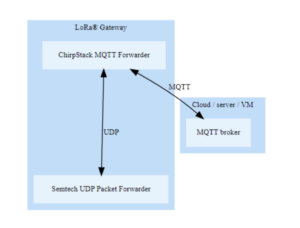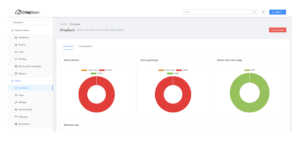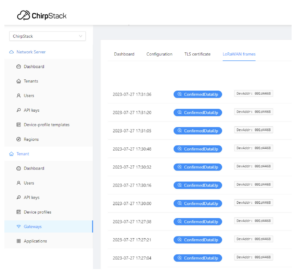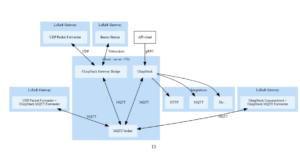ChirpStack is an open source LoRaWAN network server that enables communication between LoRaWAN devices and applications. It has a complete set of components, including network server, gateway bridge and application server, which can be used to configure and manage a LoRaWAN network.
LoRaWAN is a network layer protocol maintained by the LoRa Alliance to manage data communication in wireless LoRa networks.

ChirpStack offers a comprehensive LoRaWAN development toolkit that covers all essential components of a LoRaWAN network except the nodes themselves. This software package provides a robust solution for creating and managing LoRaWAN networks.
Here is a summary of its main components:

1. ChirpStack Hub: Handles communication between devices (nodes) and gateway hardware. Manages data transmission from LoRaWAN nodes to gateways, optimizing data reception and routing.
2. ChirpStack Gateway Bridge: Acts as an intermediary, facilitating seamless communication between the gateway hardware (specifically, the ChirpStack Concentratord) and the network server. It ensures proper data management and transmission for effective network operation.
3. ChirpStack Network Server: manages the entire network, including device activation, data routing and communication with nodes. It is essential to maintain clear, two-way communication within the LoRaWAN network.
4. ChirpStack Application Server: Provides a crucial link between the network server and external applications or services. It manages the processing, storage and integration of data with databases and dashboards, facilitating seamless interaction between the LoRaWAN network and external applications.
Together, these components form a comprehensive LoRaWAN ecosystem, covering the entire spectrum – device-to-gateway communication, network management, device activation, message passing, and integration with external applications.
ChirpStack provides a solid foundation for building and operating LoRaWAN networks, enabling efficient and secure communication for a variety of Internet of Things (IoT) applications.
Let's consider each component in more detail.
ChirpStack Concentrator
This ChirpStack component serves as an open source LoRa hub daemon. Its main function is to efficiently manage and process data transmitted by LoRa devices, commonly known as nodes. It serves as an intermediary that deftly handles the reception of data originating from multiple LoRa nodes and orchestrates a seamless transmission to the respective gateways within the LoRa network.

By leveraging a ZeroMQ-based API, ChirpStack Concentratord establishes a reliable communication channel that enables smooth interaction between LoRa nodes and gateway hardware. Its features include data aggregation, time synchronization, and error correction — ensuring accurate and optimized routing of information from nodes to corresponding gateways.

ChirpStack Concentratord is essential for improving the overall efficiency and reliability of LoRa-based communication systems. Its dedicated focus on managing the flow of data from LoRa nodes to gateways shows its importance as a critical component within the intricate network architecture.
The ChirpStack Gateway Bridge
This LoRaWAN ecosystem gateway bridge is a vital intermediary, facilitating communication between the LoRaWAN gateway and the network server. It translates data from Semtech UDP Packet Forwarder or Semtech Basics Station to MQTT format, ensuring compatibility and cohesion.
The following Packet Forwarder backends are provided:
1. ChirpStack Concentrator

2. Semtech UDP Packet Forwarder

3. Base Station Packet Forwarder
Distinguished by its open source nature, the ChirpStack Gateway Bridge encapsulates the principles of collaboration and innovation, underlining its adaptability to diverse environments. This versatile bridge can be integrated into gateway hardware or hosted on cloud infrastructure, offering network operators flexibility.
The following integrations are offered:
- Generic MQTT Broker
- GCP Cloud IoT Core MQTT Bridge
- Azure IoT Hub MQTT bridge
By converting incoming messages to MQTT, the ChirpStack Gateway Bridge essentially harmonizes the disparate components of the LoRaWAN architecture. Its ability to convert and transmit data is essential to ensure effective communication between the gateway and the Network Server.
The ChirpStack Network Server

At the heart of the LoRaWAN infrastructure is the ChirpStack Network Server, a sophisticated orchestrator responsible for coordination between the network and its multitude of connected devices. This integral component takes on the role of an astute conductor, overseeing and regulating the intricate symphony of data exchange.

The ChirpStack Network Server plays a custodial role in data integrity. It employs encryption and decryption protocols to safeguard the confidentiality of messages transmitted over the network. Furthermore, the server routes these messages to their designated endpoints, ensuring an efficient and error-free routing process.
Network Server also offers the option between cloud-based deployment or on-premises instantiation, granting stakeholders the autonomy to implement it according to their unique operational requirements.

It is important to note that ChirpStack adopts an open source spirit, accompanied by an intuitively designed web interface. Network administrators are provided with comprehensive capabilities for management, device oversight, network creation, and integration with key cloud services.
Like a nerve center, this interface empowers stakeholders with centralized control over their LoRaWAN ecosystem.
The ChirpStack Application Server
The Application Server is an essential gateway, facilitating interaction between external applications and the intricate LoRaWAN network. It has a multifaceted function that starts with receiving data from the Network Server. It later processes the data, preparing the information for further transmission to the designated application.

Along with its data-centric role, the Application Server also takes on the responsibility of device management, an essential task within the LoRaWAN ecosystem. It coordinates device provisioning, activation, and monitoring for a meticulously managed network infrastructure.
Furthermore, the server functions as a nexus for application integration, offering a tubular structure through which data is transported to various external applications. Its function extends to data storage, where it securely archives crucial information, forming a repository for analysis and historical reference.

The adaptability of ChirpStack Application Server is notable as it provides deployment options for both cloud and on-premises server environments. This flexibility ensures that stakeholders can tailor the server deployment to their specific operational context.
Conclusion
Creating a LoRaWAN gateway using ChirpStack OS is mainly about software. One option is to configure ChirpStack OS on the gateway hardware, along with a Lora hub for communication. An easier alternative is to use a pre-built gateway and add the ChirpStack Gateway Bridge software to link it to the ChirpStack Network Server.
Remember, it's the software that's crucial. The hardware mainly revolves around a Lora hub for the gateway to work effectively.

